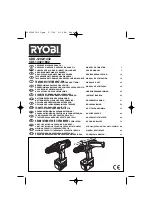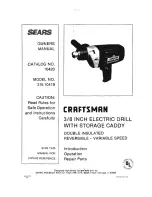
SAFETY INSTRUCTIONS cont.
9
WARNING:
Use of this tool can generate and /or disburse dust, which may
cause serious and permanent respiratory or other injury. Always use
NIOSH / OSHA approved respiratory protection appropriate for the dust exposure.
Direct particles away from face and body.
!
1.
Wear ear protectors with impact drills.
Exposure to noise can cause hearing loss.
2.
Use auxiliary handles supplied with the tool.
Loss of control can cause personal injury.
3.
Hold power tools by insulated gripping surfaces when performing an operation
where the cutting tool may
contact hidden wiring or its own cord.
Contact with a ‘live’
wire will make exposed metal parts of the tool ‘live’ and shock the operator.
4. Do not use the drill near water.
5. Do not use the drill as a screwdriver.
6. Remove the plug from the socket before carrying out any adjustment, servicing or
maintenance.
7. Fully unwind extension cords to avoid potential overheating.
8. When an extension cord is required you must ensure it has the correct ampere rating for
your power tool and that it is in a safe electrical condition.
9. Ensure your supply voltage is the same as your tool rating plate voltage.
10. Your tool is double insulated for additional protection against a possible electrical insulation
failure within the tool.
11. Always check walls and ceilings to avoid hidden power cables and pipes.
12. After long working periods, external metal parts and accessories could be hot.
13. Wear eye protection when operating this tool.
14. Maintain a firm grip on the handle when you are working. Always use the auxiliary handles
supplied with the tool. Loss of control can cause personal injury.
15.
SAVE THESE INSTRUCTIONS. Refer to them frequently and use them to instruct
other who may use this tool. If someone borrows this tool, make sure they have
these instructions also.
ADDITIONAL RULES FOR SAFE OPERATION
WARNING:
BE SURE to read and understand all instructions.
Failure to follow all instructions listed below may result in electric shock, fire
and / or serious personal injury.
!
SAFETY INSTRUCTIONS cont.
8
SAFETY RULES FOR HAMMER DRILLS cont.
6.
Maintain a firm grip
on the hammer drill to resist starting torque.
7.
Wear safety goggles or other eye protection.
Hammering and drilling operations
cause chips to fly. Flying particles can cause permanent eye damage.
8.
Wear ear protectors when hammering for extended periods
of time. Temporary
hearing loss or serious ear drum damage may result from high sound levels generated
by hammer drilling.
9.
ALWAYS use the side handle supplied with the tool.
Keep a firm grip on the tool at
all times.
Do not attempt
to operate this tool without holding it with both hands.
10. Do not overreach while operating the tool. Maintain a balanced working stance at all
times. When necessary, use only properly positioned, safe, platforms and scaffolding.
WORK SAFELY.
11.
Hammer drill bits and tools get hot
during operation. Wear gloves when touching
them.
CAUTION:
DO NOT TOUCH ANY METAL PARTS OF THE TOOL
when drilling
or driving into walls, floors or wherever tool could drill into hidden wiring. Hold the tool
only by insulated grasping surfaces to prevent electric shock if you drill or drive into a
live wire.
!
CAUTION:
Wear appropriate hearing protection during use.
Under some
conditions and duration of use, noise from this product may contribute to hearing loss.
!
• Lead from lead-based paints.
• Crystalline silica from bricks and cement and other masonry
products.
• Arsenic and chromium, from chemically treated lumber.
Your risk from these exposures varies, depending upon how often you do
this type of work. To reduce your exposure to these chemicals:
• Work in a well-ventilated area.
• Work with approved safety equipment, such as those dust
masks that
are specially designed to filter out microscopic particles.
Avoid prolonged contact with dust from power sanding, sawing, grinding,
drilling and other construction activities. Wear protective clothing and wash
exposed areas with soap and water. Allowing dust to get into your mouth, eyes,
or lay on the skin may promote absorption of harmful chemicals.
WARNING:
Some dust created by using power tools contains chemicals
known to the State of California to cause cancer and birth defects or other
reproductive harm. Some examples of these chemicals are:
!































